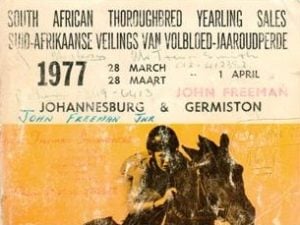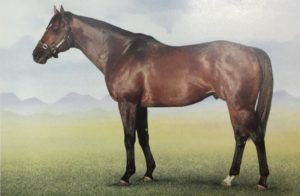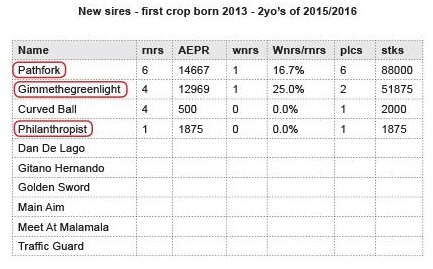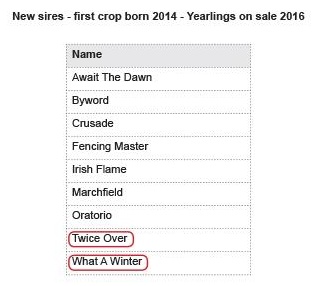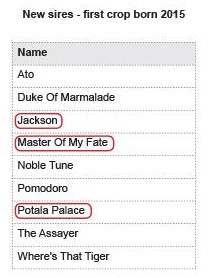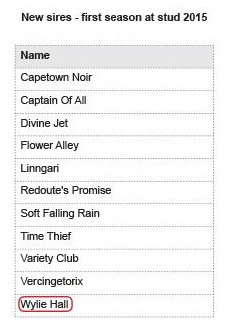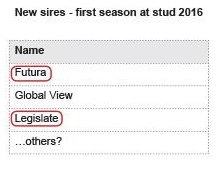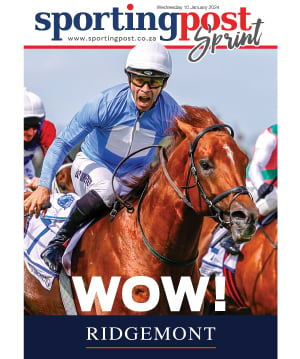We are all asking ourselves the same question – who is the next champ? If we’re honest with ourselves, we realise that we all know a hell of a lot about nothing in this industry. Certainly, with the best will in the world you need a lot of luck – but my old pal PK quite rightly used to say “you make your own luck in this game son”, writes The Thoroughbred Group‘s John Freeman.
Looking at the current sire stats, you don’t have to be a rocket scientist to know that we must give respect to the old boys at the top of the current log and search deep into the ranks of the new sires for their inevitable replacement.
Everyone is an expert in our industry – cynics abound. So you stick your hand up at a sale or buy a share of a horse and immediately you join the “racing fraternity”. You are soon coerced into drawing conclusions about a wide variety of aspects of the game. We all have a right to our opinion – irrespective of how much we think we know, or even if we are factually correct – we say it anyway. You are expected to have a view in our game.
Separating the men from the boys
I was born into the industry and attended my first yearling sale as a school boy at Milpark in 1960 and attended my first yearling sale as a runner when the sale split between Milner Park and the current day Gosforth Park in 1977. From an early age I heard the wise old men of the day challenge each other’s views on everything from cripple legs to handicapping, gambling, the politics of the sport, taxation, who is who and who is in control etc etc. The one thing that struck a common chord was the awe that they held for certain sires and their polite off-hand of those that didn’t seem to grab the limelight – you seldom heard them declare anything a total failure. Granted in those days sires didn’t cover more than 40 mares a year (compare that with the 200 odd that sires in Ireland cover today – some up to 400 in dual hemispheres in one year). In 1960 there were only about 400 yearlings on sale a year. There was no question then that what mattered most was “who owned the right stallions and who was clever enough to associate themselves with support of the great ones right from the start of their careers”. That separated the men from the boys.
Pin your colours to the mast
A natural progression of that wisdom in the modern idiom has become our modern market’s favourite past-time: it’s called “sire-trashing” and it’s the easiest call for anyone to make nowadays. No matter how well informed they are; they have that inalienable right to express a “gut instinct” about any stallion’s potential. And boy!!!! Do we make mistakes!! I have included lists of the new sires below. Please take note and make your mark – which of them are you backing. Keep a note and let’s chat about this in a few years’ time. Ok!
The most puzzling thing about any off-the-cuff critique is that it seems that the more the sire costs nowadays the more the cynicism he gets from the bright sparks – why? Because we all think we know better. Why would he cost nothing if no-one else wanted him?
It’s an international fact that the odds are heavily weighted against any stallion “making” a success of his stud career. So “trashing” is a relatively safe call for any novice to make – the nay-sayer fairly comfortable of not being proven wrong. And so what if you are proven wrong in 4 or 5 years’ time when that sire’s first crop get to the track – who would even remember your stance. What have you lost for belittling someone else’s investment? Only those that actually put their money down will remember where they stood in making that call.
Defining success
How does one define stallion “success” – what’s the yardstick? Few sires ever produce a single Gr1 winner. Surely the mere fact that any sire is able to produce just one makes him a success? Evidently not. There are sires, largely ignored by our market, that have produced multiple Gr1 winners and they reside in our top 20 ranks right now. Yet we regularly rate only the top five or so sires on the log and even then, at times, some question the right of any of them to be deemed worthy. We all have a different view on this but my rule of thumb: if a sire makes it into the top 5 at the end of any season, without his top performer having contributed more than 30% of his stakes in that season, he has made it! Surely? All sires have flaws, all need careful mating decisions, but when they are consistently amongst the top five on the log they should never be questioned for their ability to deliver the goods, warts and all. Then of course you can present various qualitative tables of sires arranged by AEPR (Average Earnings Per Runner), by number of winners, Stakes Winners and stakes races won, by % of winners, by % of stakes winners etc. With the advent of new racing surfaces we even have a log of sires on artificial surfaces and for those that don’t care, any horse winning a $1m restricted race can make his previously ignored sire the log leader overnight.
Why then are we so critical of the also-rans? Shouldn’t we be more appreciative of the value they offer – many of them have significant strike rates and some have progeny with Gr1 form to their credit. Our wise forebears would have seen loads of value to be found in that group and so should we, if only we’d bother to look. That’s where clever people shop without breaking the bank.
Boxing Clever
Our stud book has volumes proving under-rated sires that carry huge reward for little risk and anyone that was around in those days (and even today) can site examples of “bread and butter sires” that came good. For sure the old folks used to be a lot more circumspect about their criticism of other people’s sires – respect! In those days there were no large stallion syndicates. Stud farms bought and owned their stallions outright. You supported theirs and they supported yours. If you said something bad about someone’s sire it was like insulting their child and boy did you find out how to regret your careless comment when a good one made nonsense of your criticism.
Do you remember a top class sire called New South Wales? I wonder how many are aware of the fact that he was on the market just after his first freshman crop raced – how things changed soon after. There have been many others like Mexico II who shone after being considered one of the lesser lights and some like Del Sarto that were written off even after producing a brace of Gr1 horses. Cast your thoughts to more recent times with the likes of Sportsworld – I wonder how many of us remember his distinct profile.
Sportsworld
Sportsworld was what many considered a lower value sire for many years. He had a good win strike rate throughout his first 5 crops to race but no stars – and very few stakes winners! His first Gr1 winner came from his 6th crop and in that crop (1998) he got two of them: Kournikova and Sports Chestnut. The following year he got a real star in the big rangey chestnut filly Jamaica – she had 31 starts for 11 wins, 14 places and R2.4m (in those days). She won 3 Gr1 races and won or placed in 17 stakes races. She made people take note of Sportsworld for the first time.
Sportsworld’s soundness rate in this 6th crop (runners : foals born) was 90% and it also happened to be his biggest crop ever produced (52 foals). That crop delivered, apart from the champ Jamaica, a healthy 62% winners. The market took 6 years to get to grips with this sire. The smart money stayed with him and were rewarded. The following year he got two talented fillies Princess Kay and Sabina Park and another 90% soundness rate and an equally healthy 66% win-strike rate. Only then did people started paying attention to his yearlings in the sales ring – ironically, it was too late, they’d missed his prime time.
Sportsworld’s fertility declined in 2001 and his crop of 2002 saw a rapid decline in his stats – he got only one modest stakes winner in that crop. His crops of 2003 and 2004 had very bad stats but his yearlings on sale were still attracting big numbers right up and until his last crop of 34 foals born in 2005 – that crop produced only 25 runners, 13 winners and 4 stakes place getters.
The point I hope I have made here is that the market paid much more for the yearlings of lower delivering sires and only stepped into Sportsworld’s glory just as his stats started to decline. He is a classic example of just how little we know about sires or are able to make accurate predictions of their potential. I can think of many other examples. I couldn’t afford to play in the richer field and had to hunt for value at sales. Sires like Argosy, Caerdeon, Folmar, Hobnob, Roland Gardens and many others weren’t the top sellers and yet consistently delivered a high strike rate with the very real chance of producing a good one.
Talk is cheap, money buys the whiskey
The stallion market need not be that much of a lottery. With some savvy you can definitely load the odds in your favour. The buyer has clear advantage – be critical, buy value or walk away. Stallion owners take most of the risk and unfair market scepticism. The cost of buying top class performers internationally has become prohibitive. With yearling prices setting new records globally every year it’s getting harder to afford the best bred best looking yearlings and even harder to try and buy them as proven horses off the track for stud. We all know that even the best bred, best raced, best conformed, best supported etc etc can miss the mark but the chances of class repeating itself remains however so much higher if you start with class in the first place. One thing is for sure: anyone that has ever bred a winner knows how hard it is to breed a stakes winner – anyone that has started the career of any sire knows how hard it is to get him to the top of any sire log. As my late dad used to say: “talk is cheap, money buys the whiskey”.
Cycle
The current cycle of sire supremacy is reaching its peak. This is not a new phenomenon – it’s a regular cycle, like climate change. Out with the here-and-now and in with the new. The boys at the top of the current log can’t go on for ever. New blood is coming through and there has to be loads of potential in sires that have just started their careers and in the new crop of freshman sires. The timing of this impact has important coincidences that will weigh very heavily on how we judge these new stallions; and it’s happening right now. There has never been a better or more important time for the new lights to shine in our stallion industry.
A prominent breeder came to my cubicle at the National 2yo Sale several years ago quizzing me on the new sires. The conversation centred around the fact that the older sires were hard to access and were, as always, expensive. We were deliberating which of the new sires they should support that season. I get no prizes but I clearly remember telling them that I thought Captain Al and Dynasty were the right ones to back. Always loved those two. Dynasty had a full season of 2yo’s racing by that stage – his 10 juvenile winners didn’t compare to Captain Al’s 30 but for a sire that had so much stamina it was a very good freshman crop in my view. Captain Al was in his 3rd season then and already stamped as a popular success story. He was easily accessible and was obviously on the list. They had shares in both of these new sires and bought extra nominations to both – wise move. Captain Al became champion sire of 2yo’s in the next season for the first time (and has won that championship every year since – seven times in succession). Dynasty’s first crop of 3yo’s that season delivered his first Horse Of The Year Irish Flame, Gr1 winner Ancestral Fore, Gr1 performer Blake and 41 winners from 58 runners in just that relatively small crop. These two joined Jet Master in an assault on the established old sires at the top of the log and were soon joined by Trippi and Silvano who have been there since in a four horse race.
Like I said before – its like the cycle of climate change. Inevitable!
What the numbers say
So let’s bring this to basics: the perennial log leaders are getting on. The next five on the list include two sires based some way from the main Cape breeding grounds. There are some older unfashionable sires in the mix with some value sires in between and at least one new bright star who has already shown his mettle with an incredibly high win strike rate and a good Gr1 2nd placed 2yo in his freshman crop last season. The stats below provide a valuable window into the current state of affairs.
It’s patently obvious – the opportunity for new sires to shine has never been better. Never before has it been more important to have numbers on your stallion’s side. There are 10 new sires with freshman 2yo runners this year – only four of them have had runners – two of them have had their first winners. Put your neck on the line – who is this years champion freshman sire?
Nine of the sires that retired in 2013 have their first yearlings on sale this year. If the yearling market is any gauge of their potential; What A Winter (headed up the CTS Premier Sale Freshman sire list) with Twice Over and Oratorio the next most popular. Put your neck on the line again.
Nine more had their first foals born in 2015 – take your pick from the list below and share it with me – we can compare notes in a few years’ time and see where the smart money was:
Eleven new sires covered their first mares in 2015 – a very interesting bunch against whom we are backing our choice – Wylie Hall:
2016 is off to a very bright start with the champions Futura and Legislate already on our board – whoever takes them on has a tough race on their hands.
(With thanks and kind permission of John Freeman and The Thoroughbred Group)




